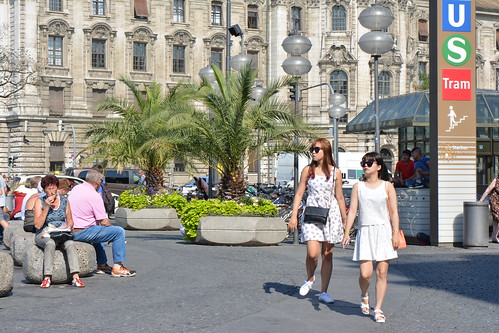A new thought about Uber and Lyft as mobility/transportation services operating on a national footprint
One of the things that's problematic with "learning" how to ride transit is that transit is organized at the local, metropolitan, and regional scale, alongside a couple of nationally branded services (besides airlines, Amtrak, and the Greyhound and Trailways national bus lines), plus airlines.
Besides transit agencies all having different names for service, e.g., the T in Boston, the NYC Subway in NYC, the L in Chicago, Metrorail in DC (and many other places use the same name, or its variant, Metro; local and circulator and express bus services), with various names depending on how transit is organized in a particular area, most use different names, processes, transit media cards, machines, etc.

Karlsplatz, Munich, Bavaria, Germany
The Germans make it a little easier, having standard logos used across the country to denote the main types of services: Underground/Subway service; the U-Bahn; and local commuter rail, the S-Bahn; and a standard logo for bus services too.
But even Germany is a bit inconsistent in a common designation for light rail/streetcars, which in Europe are called trams either as light rail or streetcars. Light rail services are called Stadtbahns, but there isn't a consistent logo like there is for the U- and S-Bahn services. As shown above, in Munich they label these services as "tram."
You Besides knowing what it's called, you need to know what operates where, where bus stops and stations are located, have the right payment medium, etc. Transit agencies may not have well integrated the ability to get information and transit cards at places like airports, etc. (WRT airport transit information Chicago at O'Hare and Cleveland at its airport are particularly good at explaining what's up.)
WRT payment media, most metropolitan areas now have an integrated fare media card and system that works across most or even "all" of the services. For example, while most transit media systems don't include commuter railroads, the systems in the SF Bay and Puget Sound areas do include railroads (Caltrain, Sounder) and ferries too.
While it's true that if you know how to use one multi-faceted transit system well, you can usually figure out how to use it elsewhere, perhaps most people, especially "younger people" (often called "digital natives") aren't interested in spending the time and energy figuring it out.
Instead, they often use an app on their phones to "hail" or order a taxi, but not a "local" taxi -- local taxi services can be even more balkanized than transit services -- but a so-called "transportation network company" ride hailing service like Uber or Lyft.
And the advantage is that as long as these companies have their service available where you are at or are going to--other major cities--you can use the same app and process "universally," at the scale of the entire nation.
(In Ontario, with a couple exceptions, all transit agencies use the same fare card system, which was created by the Province.)
Perhaps that's some of the attractiveness of ride hailing services, despite the fact that they usually cost more than transit, especially if cost isn't the main concern, but convenience and ease of use is.
Note that Zipcar and Car2Go operate at the national scale too, although you have to switch the app to the right city (and it's pretty cumbersome to do in Zipcar). When it works, it works great. We've used Car2Go in Seattle, San Diego, and Brooklyn, and Zipcar in Seattle and San Francisco.
Labels: car sharing, collaborative consumption, taxi services, transit marketing, transportation planning




0 Comments:
Post a Comment
<< Home